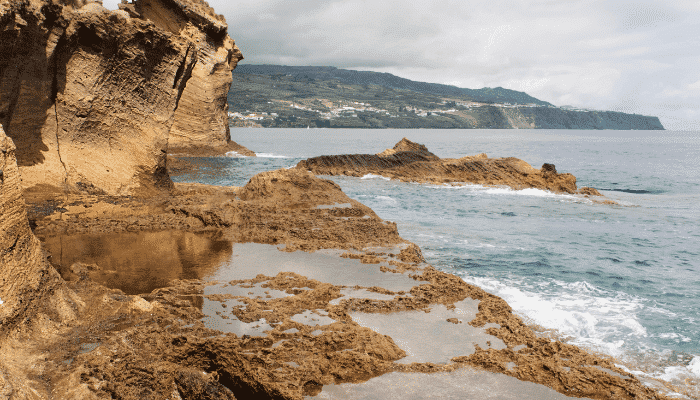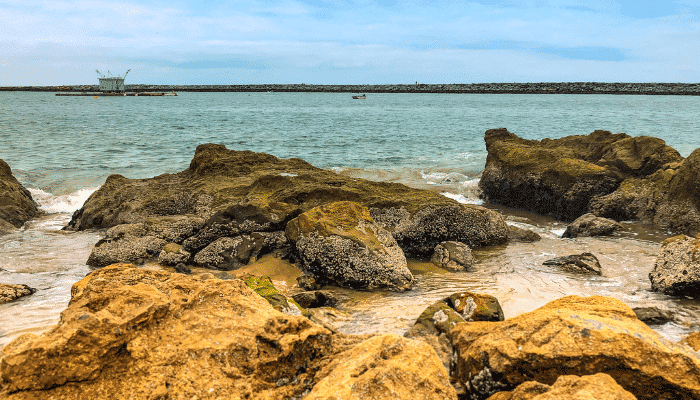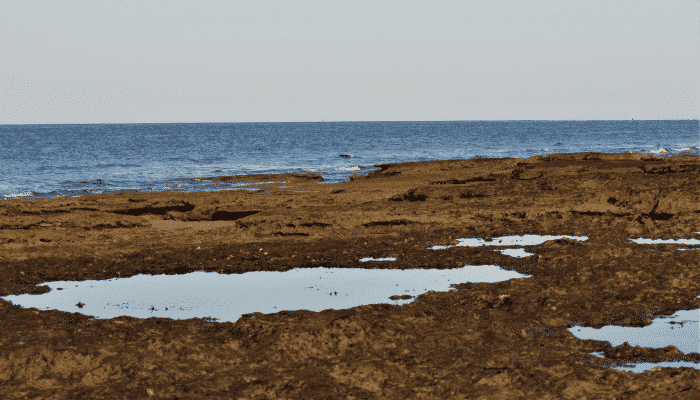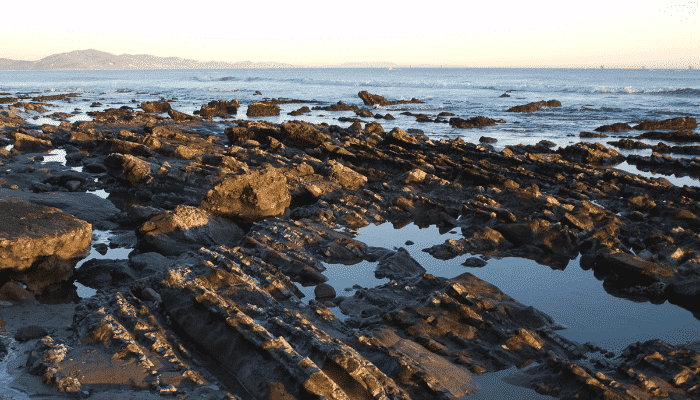What Are Tide Pools?
What Are Tide Pools?
When you’re at the beach or close to the sea, the high and low tides are very interesting to observe. A large number of crabs, mussels, and other creatures are often swept out of the water.
It is also an ideal time for tourists and visitors to experience the beauty of the sea. But it is also an excellent opportunity for marine biologists and oceanographers to study the inner dynamics of the underwater world.
We have heard of lagoons and coral reefs. But there are different phenomena many of us have never seen or heard about. And today’s article is also about one such phenomenon- tide pools.
Over the course of millions of years, rocks near the coastline have been weathered away by wave and wind action to form sand particles. Others are too large and have only been smoothened or carved out.
With time, depressions may form on corals and rocks near the shore, leaving them with a dip on their surface. During the high tide, the rock is submerged and marine life continues around it.
But during the low tide, water is held in this depression and marine creatures are trapped in it. Such a depression in rocks and corals that holds small pools of water during the low tide is known as a tide pool.
While tide pools may seem mundane or outright boring, they are marvels of nature in reality. The geology and biology behind these pools continue to fascinate and bewilder scientists.
In this article, we look at the world of tide pools, tidal variations, exploration tips, and the challenging life of marine flora and fauna that lives within it.

Tides And Their Zonal Variations On Tide Pools
Since the tide pool is only visible when the sea pulls away from the shore, it is dependent on the tide zonal variations. Different ocean or sea zones are divided based on exposure the substratum receives to open-air conditions.
The various zones depending on how far they are from the coast and the typical tides that can be expected.
The 3 common zones are (as per oceanographic classification):
1. Low tide or lower littoral zones are away from the coastline and stay submerged except during very low tides. Marine creatures in the lower littoral zone are well adapted to spending long periods underwater but cannot survive when they are exposed to the sun. Temperature variations and dryness are causes of concern for these creatures. Since marine vegetation has more space to grow in, organisms of this region are also generally larger.
2. High tide zones are only submerged during the high tide, meaning that the sea bed is often left exposed for long periods to the sun. Creatures in this region have to face very harsh conditions including drying, high temperatures, sudden and often jarring waves, long periods without food, and frequently being stranded on the beach. Only a few creatures such as seaweed, crabs, mussels, and chitons can survive in this region.
3. Intertidal zones are regions in between low and high tide regions, and where tide pools are commonly found. They are submerged during the high tide, but not completely when it’s the low tide. The coral and rock depressions allow just enough water to accumulate as the sea recedes. This region undergoes a wide variety of natural phenomenon that put the creatures living within it under stress. Wave forces (during high tide) and high temperatures (during low tide) are just 2 out of a plethora of problems including hunting by predatory land creatures and birds.
During the high tide, these pools are filled up and creatures are often exchanged between it and the rest of the sea. During this period, nutrition is supplied to creatures in the high tide and intertidal zones.
At a mid-tide level, the pool remains submerged, but organism exchange is very rare and nutrition has been restricted to the intertidal zone.
At low tide, the pools are exposed to the natural elements, and the organisms are left only with the nutrition available within the small pool.

What Makes Life Difficult For Creatures In Tide Pools?
Tide pools are classified by marine biologists as one of the harshest living conditions on Earth, for a variety of reasons. From the lack of nutrition to the high temperatures, the inhabitants of tide pools need to weather different conditions that put their bodies under stress.
In this section, let us take a look at some of these conditions and the factors that make living in a tide pool incredibly difficult.
1. Increased danger of predators. This ranks on our list as one of the top challenges faced by tide pool dwellers. During low tide conditions, different groups of creatures are trapped or herded into tide pools, with natural predators often in the same pool as their prey. Common examples include different varieties of fish that hunt snails, mussels, and crabs that are trapped within the pool. If not the predators in the pool, these organisms are easy targets for land creatures.s
2. High temperatures. The majority of creatures in the ocean have adapted to survive in mild to constant temperatures. Thermoclines and haloclines often limit the level of temperature variation, so creatures living in a certain oceanic zone are suited to a particular temperature range. However, organisms trapped in tide pools experience large variations- cooler weather during high tide and at night, and much higher temperatures during low tide when the pool is exposed. The soaring temperatures are compounded by the refractory nature of white coral. Most marine organisms are unable to cope with this temperature fluctuation and have resorted to evolutionary changes to regulate their body temperature.
3. Reduced area to swim. As the low tide sets in and water levels fall, creatures trapped in tide pools often find themselves with a small area to survive in. Compared to the vast expanse of the ocean, this creates a problem of space and movement. For creatures such as mussels, snails, and small marine organisms, this does not pose a major problem since they are generally sedentary. Even crabs or other creatures that can survive both on land and water can leave the pools if required. However, larger fishes require a significant area to swim and stay active. They are dependent on this motion to regulate their body temperature and the reduced space severely inhibits this ability.
4. Reduced space on the substratum. Tide pools will almost always have water in them, although it may be lower than usual. This makes it an ideal location for organisms that are sedentary and often fixed to the substratum. Starfish, sea sponges, and sea anemones attach themselves to the substrate and flourish. They only require a small area to create a foundation and thrive off minimal nutrition. Moreover, they often feed on the bi-products of other organisms trapped in the tide pool. These factors result in a large number of such organisms settling on the substratum. While this does not appear to be a problem initially, it takes up space for oxygen-producing plants that help the ecosystem. Fishes require these underwater plants to replenish oxygen levels throughout the day.
5. Currents and strong waves. During the high tide, creatures not attached to the substratum can be seized and pushed away into the ocean or towards the shore. Here, they are an easy target for birds and other creatures that can pick them up. Common examples include predatory birds feasting on mussels, snails, starfish, and clams. On the shore, large crabs and mammals often hunt marine creatures washed up.
6. Competition for food and resources. The lack of oxygen-producing plants in tide pools often places a constraint on organisms trapped in the pool. To further compound this problem, creatures often have to compete amongst themselves for food such as phytoplankton and zooplankton. Most marine creatures require these sources of nutrition but face competition for them.
For all the uncertainties of the tide pool, the only constant is that life for these creatures is challenging, and they often undergo evolutionary adaptations to increase their chance of survival.
What compounds the harsh living conditions is that at low tides, there is a simultaneous lack of water, increase in temperature, and dip in the number of available nutrients. Thus, creatures must adapt to handle these drastic changes.

How Do Marine Creatures And Plants Survive Life In A Tide Pool?
Since they lead a very difficult life, these marine creatures have evolved over millennia to handle extreme conditions. In this section, we will look at some of their evolutionary and physiological adaptations.
1. To keep smaller creatures safe from being hunted by larger predators within the tide pool, organisms have evolutionary features such as stings and spines. This discourages predators from attacking and eating smaller organisms. Other species have evolved to regenerate when they are attacked. Starfish and some species of sea sponges can regenerate from their arms. This is because vital organs are easily grown and housed within the arms of the starfish. Thus, even if they are attacked, the starfish can completely grow back if a small part is left behind.
2. High temperatures are a part of life for organisms trapped within the tide pool, and the most common evolutionary feature is enhanced resistance to heat-related illnesses. Creatures have adapted to slow down their body functions, produce less heat, and improve their heat regulation systems. By slowing down and staying sedentary, creatures in these tide pools can quickly bring down their temperature. Some of them also pass out bi-products that further bring down their temperature, similar to how we sweat when the temperature increases.
3. When evolution encourages creatures trapped in tide pools to reduce their motion, the problem of a reduced area to swim in is automatically countered. Since all creatures within the pool have to bring down their body temperatures, there is often little to no competition for space amongst larger creatures such as fish and crabs. They spend long periods in a sedentary position to conserve energy.
4. Since space is a premium in a tide pool, creatures often have to fight members of their species for a spot on the substratum. The most common example is sea anemones of the species Anthopleura Sola that have stinging rays attached to their arms. They use these to engage in fights with other anemones and force them out of their territory. By repeatedly striking competitors with these stings, they can preserve a region of the substratum. Larger creatures often simply consume smaller species and take over their space and nutrient quota. Life in the tide pool is harsh, and only the strongest species survive.
5. To overcome the problem posed by strong winds and currents, creatures in the tide pool attach themselves to the substrate using a pedal disc or foot. Other creatures have evolved to cling to the surface by using microscopic suckers underneath their body. However, only a few organisms possess these features, and the vast majority of them are at the mercy of the winds and currents. The bright side to this is that if pushed out towards the ocean, these creatures can escape from the tide pool.
Competition for food is an evolutionary problem irrespective of whether you are in a tide pool or on land. Charles Darwin’s maxim still stands and summarizes the life of a creature in a tide pool- survival of the fittest.

How Should You Undertake A Visit To A Tide Pool?
Due to the misconception of what a tide pool is, they are considered exotic tourist spots. When you have the chance, a visit to the nearest tide pool is in order. You will be left amazed at the life that flourishes within this small body of water. Moreover, you get to see all that we have covered in this article for real.
But as with any visit to a natural ecosystem, there are some steps to be followed to ensure that you can enjoy this chance of a lifetime while also remaining safe.
Many of these points have been advised by organizations such as the National Oceanic and Atmospheric Administration (NOAA) which is based in the United States.
1. The first thing to keep in mind is that tide pools may not be visible or accessible at all times of the day or year. Before heading on the visit, check with a local guide or expert to ensure that you won’t miss the sighting. The main thing to keep in mind is that these pools are accessible safely only during the low tide, so factor that into your travel timing.
2. Once you have reached the pool during the low tide, remember to also keep track of the scheduled high tide period. Just like a tsunami, tides are notorious when it comes to announcing their arrivals. They can often creep up on you until you find yourself suddenly stranded in the middle of the sea. Take turns with members in your group to keep an eye out for the returning high tide.
3. Always ensure you wear waterproof shoes that have a good grip. These are essential to finding a secure footing on the tide pool without slipping. The corals or creatures that live in the pool can cause serious injury if they come in contact with your bare feet, so it is advised to exercise caution when walking around. Many brands advertise coral shoes with expensive price tags. While these are bound to provide all-around protection, the main points to keep in mind are that the shoe has a good grip, is waterproof, and has a sturdy sole that cannot be easily pierced by the rocks.
4. Since the creatures of the tide pool experience stress (in the form of hypoxia and excessive body heat), they are very sensitive to external influences. When you approach them, avoid coming in contact or putting them under undue stress. Some organisms may also be small and easy to mistake, so take care when walking over the corals and rocks.
5. Lastly, tide pools are protected areas since the organisms within them are often rare or endangered. Do not litter in such areas, and collect any left-over trash from your visit. Have fun but also keep the environment clean and free of pollution.
As you can see from this article, tide pools are often far more complex than meets the eye. From the unique ecosystem it supports to the natural beauty on display, they truly are a magnificent sight to see on your next visit to the coastline or beach.
You might also like to read:
- 11 Threats to Marine Environment You Must Know
- Top 10 Amazing Ocean Mysteries and Phenomena
- Top 10 Amazing Ocean Mysteries and Phenomena -Part 2
- 15 Amazing Facts About Coral Reefs
- 8 Facts About Waterspouts at Sea
- What is a Mid Ocean Ridge?
Disclaimer: The authors’ views expressed in this article do not necessarily reflect the views of Marine Insight. Data and charts, if used, in the article have been sourced from available information and have not been authenticated by any statutory authority. The author and Marine Insight do not claim it to be accurate nor accept any responsibility for the same. The views constitute only the opinions and do not constitute any guidelines or recommendations on any course of action to be followed by the reader.
Do you have info to share with us ? Suggest a correction

About Author
Ajay Menon is a graduate of the Indian Institute of Technology, Kharagpur, with an integrated major in Ocean Engineering and Naval Architecture. Besides writing, he balances chess and works out tunes on his keyboard during his free time.
Subscribe To Our Newsletters
By subscribing, you agree to our Privacy Policy and may receive occasional deal communications; you can unsubscribe anytime.



